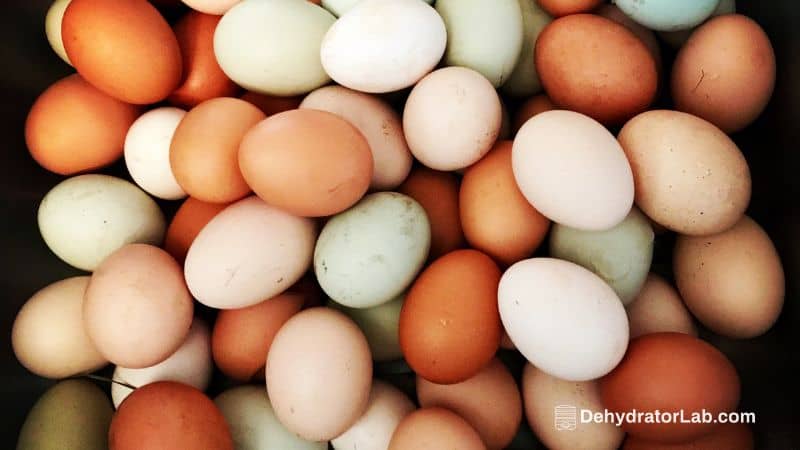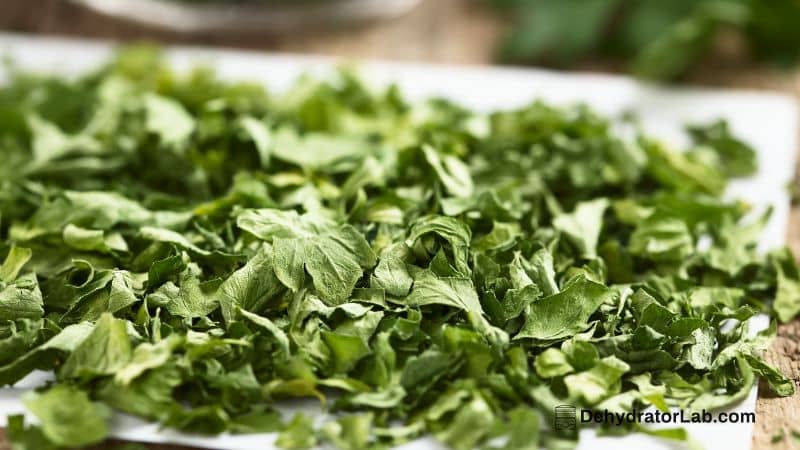Say goodbye to wasted zucchinis and hello to convenient, space-saving snacks and recipe enhancements.
In this article, we unveil a step-by-step guide on how to dehydrate zucchini, allowing you to extend its shelf life while unlocking its culinary potential.
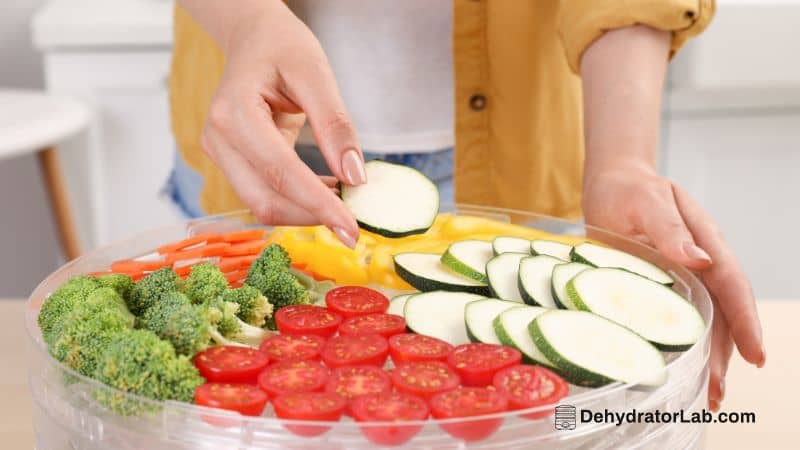
As an Amazon Associate, I earn from qualifying purchases. If you make a purchase after clicking on a link I may earn a small commission at no extra cost to you if items are purchased.
In this article:
The Benefits of Dehydrating Zucchini
Dehydrating zucchini is an easy and effective way to preserve this nutritious vegetable. Not only does it help extend the shelf life of the vegetable, but it also concentrates its flavor, making it a fantastic ingredient to use in various dishes.
Dehydrated zucchini retains most of its nutrients while losing water content, making it an excellent source of dietary fiber. One of the key benefits of dehydrating zucchini is that it allows you to enjoy this vegetable throughout the year.
Unlike fresh zucchinis, which have a short shelf life and can spoil quickly, dehydrated zucchinis can last up to a year when stored properly. This means you can use them all year round in soups, stews, salads, or as a healthy snack!
Dehydrated Zucchini in Various Dishes
Dehydrated zucchinis are incredibly versatile and can be used in countless recipes. They make for an excellent ingredient in snacks such as chips or crackers or toppings on salads and pizzas.
One great recipe idea is making zucchini chips using your dehydrated slices with some avocado and olive oil, for a healthy snack high in nutrients. You can also add them to soups or stews during winter months or rehydrate them by soaking them in water before using them in recipes where fresh vegetables are called for such as yellow squashes.
You can even grind them into powder form with some fresh herbs and use them as seasoning for various dishes! Another great thing about dehydrating zucchini is how simple it is to do!
All you need are some clean, washed zucchinis sliced thinly with a mandoline slicer (or by hand), arranged onto trays lined with parchment paper or baking sheets, and left to dry out. You can use a dehydrator or an oven set on low heat to dry zucchini.
The result is crispy, dry zucchini that’s ready to be used in other dishes or stored in an airtight container. Dehydrating zucchini is not only easy but also highly beneficial.
It allows you to enjoy this nutritious vegetable all year round while unlocking its full potential in recipes like soups, stews, salads, or as a healthy snack! In the following sections of this article, we will explore the various methods for drying zucchini and how you can store it for future use.
Preparing the Zucchini
Wash and Dry the Zucchinis Thoroughly
Before we can start dehydrating zucchini, we need to prepare them first. The first step is washing and drying them thoroughly.
It’s crucial to remove any dirt or debris on the surface of the veggies. If you’re working with organic zucchinis, there might be insects, so pay extra attention.
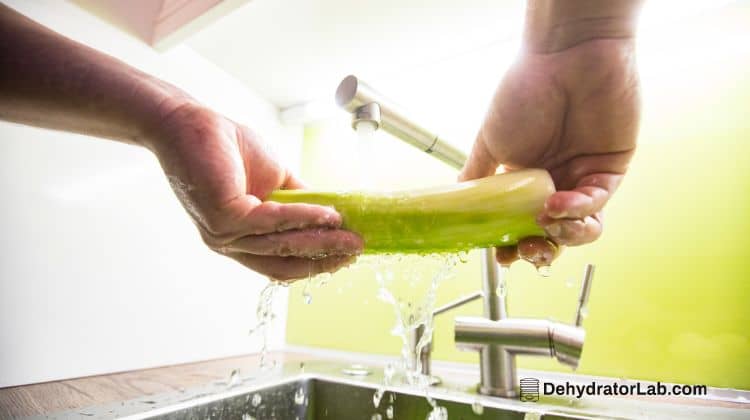
To wash, rinse each zucchini under running water for a few minutes and scrub it gently with a brush. After washing, dry them out with a clean towel or let them air dry on a rack.
Cut Off Both Ends of Each Zucchini and Slice Them into Thin, Even Pieces
After washing and drying the zucchini, it’s time to cut them into thin slices. Start by trimming both ends of each vegetable with a sharp knife. Next, using either a mandoline slicer or your trusted knife skills, slice the zucchini evenly.
The thickness of your slices should be around 1/8 inch thick if you want crispy chips after dehydration; you can also make thicker cuts if you prefer chewier textures in your snacks. It’s important to keep all pieces uniform in size so that they dehydrate evenly without over-drying some parts while leaving others moist.
If cutting even slices seems challenging for you because of uneven veggies’ shapes or sizes, use a mandoline slicer as it provides consistent cuts that will come in handy during the dehydration process. When slicing is done cut any overly thick pieces in half lengthwise to speed up the drying process since thicker pieces take longer time to dehydrate than thinner slices.
After slicing your zucchini into thin pieces place them aside while preparing for dehydration. Now that our zucchini shreds and vegetables are prepared let’s move on to how we are going to dehydrate them!
Dehydrating Methods
Using a Dehydrator: Pros and Cons
Dehydrators are great tools for anyone who wants to experiment with dehydrating fruits, vegetables, and herbs. They allow you to quickly and easily remove all the remaining moisture from your food, leaving it crisp and flavorful.
The biggest advantage of using a dehydrator is that it is specifically designed to dry out food items, providing an even distribution of heat over a long period of time.
This means that you can achieve uniform thickness in your dried zucchini slices. Another pro is that many dehydrators come with multiple trays or racks so you can dry several vegetables at the same time.
But the downside is that they can be relatively expensive, especially if you’re just starting out. If you’re on a tight budget, there are other ways to dehydrate zucchini.
If you decide to use a dehydrator for making zucchini chips, set it up according to its instructions. Arrange sliced zucchini on the trays in one layer.
Don’t overlap them or they will stick together during the drying process. Turn on the machine and let it run for 8-12 hours depending on how thickly sliced your zucchinis are.
Using an Oven: Pros and Cons
If you don’t have a dehydrator or don’t want to invest in one right now, using an oven could be another option for making dried zucchini chips or other snacks from yellow squashes. It’s easy and doesn’t require any special equipment apart from baking sheets lined with parchment paper.
The biggest advantage of using an oven is that most people already have one at home which makes it more accessible than purchasing additional equipment such as dehydrator machines. The downside is that ovens aren’t made specifically for dehydration purposes so there might be uneven heat distribution.
To dry zucchini in an oven, preheat it to its lowest setting, around 140°F (60°C). Arrange the sliced zucchini on a baking sheet lined with parchment paper and put it in the oven for 3-4 hours, flipping them halfway through.
Which Method Works Best?
Both methods have their advantages and disadvantages. The best option depends on your personal needs, budget, and available equipment.
Generally speaking, dehydrators are more efficient than ovens for drying food since they are made specifically for that purpose. However, if you don’t want to invest in a dehydrator or don’t have the space for one, an oven is a good alternative.
When making dehydrated zucchini chips at home using either method remember that they’re healthy snacks that can last up to a year if stored properly in an airtight container or vacuum-sealed bag. They’re low-carb and keto-friendly too so they are perfect for those following special diets.
Whichever method you choose to make zucchini chips make sure you use a sharp knife when slicing your zucchini into uniform thicknesses; this will ensure even drying times and better results when making dried zucchini chips. You can even add some freshly grated parmesan cheese before putting them into the oven or dehydrator.
Or how about trying out some sour cream mixed with fresh herbs as dipping sauce? Keep experimenting with new recipes that use dried zucchini as an ingredient or munch on them plain like potato chips!
Using a Dehydrator
Setting Up Your Dehydrator
If you’re using a dehydrator to dry your zucchini slices, the first thing you need to do is familiarize yourself with your machine. Although each brand may be slightly different, most dehydrators have similar features and uses. Begin by reading the manufacturer’s instructions carefully.
This will help you determine how to properly set up the dehydrator for optimal results. Most models come with several trays that can be stacked on top of each other or separated depending on how much food you want to dry.
Avoid Overlapping and Achieve Uniform Thickness
Once you’ve read the instructions, it’s time to start preparing your zucchini slices for dehydration. Start by washing and drying your fresh zucchini thoroughly. Then, use a sharp knife or mandoline slicer to cut them into thin slices of uniform thickness.
It’s important not to overlap the zucchini slices when arranging them on the dehydrator trays because this will prevent them from drying evenly. Make sure that they are placed in a single layer on each tray and leave some space between them so that air can flow freely.
Drying Zucchini for 8-12 Hours
Now that your dehydrator rack is set up and your zucchini slices are prepared and arranged properly, it’s time to turn on the machine! Set it to its appropriate temperature setting according to the manufacturer’s instructions which are often between 125-135°F (52-57°C).
The drying time depends on various factors such as humidity levels and thickness of the slices but generally takes 8-12 hours. You can check if they are completely dried by touching their surface; they should feel completely dry without any soft spots indicating excess moisture remaining.
After 8 hours have passed, simply check if they are dry enough, and if not, run the dehydrator for another half hour. Once they are completely dried, you can store them in an airtight container or vacuum-sealed bag until ready to use.
Make Dehydrated Zucchini Chips
One of the most popular ways to eat dehydrated zucchini is by turning them into keto zucchini chips.
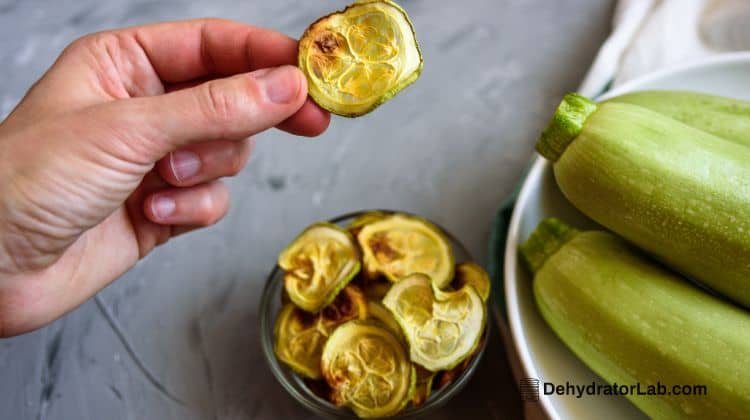
After drying and storing your zucchini slices, lay them out on a baking sheet and bake in the oven with some oil and spices until crispy. You can now enjoy your homemade, healthy alternative to potato chips with your favorite dip!
Cleaning Your Dehydrator Trays
After drying your zucchini slices, it’s important to clean your dehydrator trays thoroughly to prevent any bacteria from forming. You can simply wipe them down with a damp cloth or wash them in warm soapy water before storing them away for future use.
Using a dehydrator is an excellent way to dry fresh zucchinis that can be used in many creative ways such as making delicious chips! Following these simple steps on how to dehydrate zucchini and paying attention while arranging the slices on single layers without overlapping will ensure they dry evenly and taste great when stored properly.
Using an Oven
Preheating the Oven
Dehydrating zucchini using an oven is pretty straightforward. First, you need to preheat your oven to its lowest temperature setting. This will ensure that the zucchini slices dry out evenly without burning them.
Usually, this temperature is around 125-135°F (50-57°C). It’s crucial not to set the temperature too high because it could cause the zucchini slices to cook instead completely cool because of dehydration.
Preparing the Baking Sheet
Next, you’ll need a baking sheet and parchment paper. Line your baking sheet with parchment paper to prevent sticking and make cleaning up easier afterward.
Arrange the sliced zucchini in a single layer on top of the parchment paper, making sure they don’t touch each other. If they overlap, they won’t dehydrate properly.
Baking Time and Flipping
Once everything is set up, it’s time to put your baking sheet in the oven and let it work its magic for three to four hours. Be sure not to open your oven door too frequently or leave it open for too long as it could disrupt the temperature inside – risking uneven dehydration or burnt slices.
It’s essential to keep flipping them every hour so that both sides are exposed evenly and can dry out correctly. You can use a spatula or tongs for this or simply shake the tray gently so that each slice moves around.
Checking For Moisture Content
Towards the end of baking time, check if there’s any excess moisture left in your dehydrated zucchini chips by removing a few slices from various parts of your tray and letting them cool down completely on a wire rack before checking their texture manually (or by snacking on them!). The texture should be crispy rather than chewy or soft.
Storing Your Oven-Dried Zucchini
Once you’re sure that your zucchinis are fully dehydrated, remove them from the oven and let them cool down completely. You can store them in an airtight container or vacuum-sealed bag to protect them from moisture. Keep it in a cool, dry place, away from direct sunlight.
These crispy goodies stay fresh for weeks and make a great snack on their own or dipped into your favorite dip! Using an oven is a convenient method to dehydrate zucchini if you don’t have access to a food dehydrator.
It’s easy to set up and requires minimal equipment: fresh zucchini, a sharp knife or mandolin slicer, a baking sheet, parchment paper, and an oven. With these simple steps covering how to dehydrate zucchini chips, using the oven method as outlined above will yield delicious zucchini chips that are healthy and versatile additions to any diet – like keto zucchini chips with Parmesan cheese or garlic powder added for extra flavor!
Storing Dehydrated Zucchini
Airtight is the Way to Go
Once you have gone through the drying process and your zucchini pieces are nice and crispy, it’s time to store them. Make sure that they cool down completely before doing so. As a rule of thumb, you should let them sit out for 30 minutes to an hour before packing them up.
It’s important that you don’t rush this step because any residual moisture can cause mold growth in your dehydrated food over time. When it comes to storage containers, an airtight container or vacuum-sealed bag is the way to go.
You don’t want any moisture or air getting in and ruining all of your hard work. A mason jar with a tight-fitting lid works great as well.
Keep ‘Em Cool and Dry
Now that you’ve got your zucchini chips safely stored away, it’s important to keep them in a cool, dry, dark place away from direct sunlight. A pantry or cupboard is ideal for this kind of storage. Avoid keeping them near any sources of heat or humidity like near the stove or dishwasher.
If stored properly, dehydrated crispy zucchini chips can last up to a year without losing their flavor or nutrition calories. It’s also worth noting that because zucchini is low-carb and keto-friendly, these crispy zucchini chips make for a great snack option on those diets.
Recipes Featuring Dehydrated Zucchini
Now that you’ve successfully dehydrated your zucchinis and stored them away, it’s time to start experimenting with recipes! One great way to use these chips is by creating homemade keto zucchini chips as a healthier alternative to potato chips.
For this recipe, preheat the oven at 350°F (175°C) first before mixing your dehydrated zucchini chips with parmesan cheese, black pepper, and garlic powder. Then, spread them out on a baking sheet and drizzle some avocado oil over the top.
Bake for 3-5 minutes until they’re crispy and enjoy them immediately! Another great use for these chips is rehydrating them before adding them to soups or stews.
Dehydrated zucchini flour is a great food to have on hand for snacking or cooking. It’s easy to make zucchini chips, and storing them properly will keep your dehydrated food fresh for a long time.
With some experimentation in the kitchen, you’ll find that there are many creative ways to use your dehydrated zucchinis in various dishes. Enjoy!
Creative Ways to Use Dehydrated Zucchini
Add them as toppings on salads or pizzas
Dehydrated zucchini makes for a crunchy and healthy addition to any salad or pizza. You can sprinkle them on top of a Caesar salad, or add it as a topping on your homemade pizza for an extra texture.
You can even mix it with other dehydrated vegetables like yellow squash, bell peppers, and onions to create a colorful and flavorful topping. For a keto-friendly option, try making dehydrated zucchini chips by seasoning thin slices with garlic powder, salt, and pepper before dehydrating them.
After they’re done, toss them in some avocado oil and air fry until crispy. These chips make the perfect guilt-free snack that you can enjoy any time of the day.
Rehydrate them by soaking them in water before adding them to soups or stews
Dehydrated zucchinis are great for adding texture and flavor to soups and stews. To rehydrate them properly, soak the dried zucchinis in water for about 30 minutes or until they become plump again. Once rehydrated, add them to your favorite soup recipe along with other vegetables like carrots and celery.
The water from rehydration will be infused with nutrients from the zucchinis making your soup more flavorful. You can also use this method for making vegetable stock by boiling dried vegetables such as onion flakes, dried carrots, and garlic powder together with seasonings of your choice then strain out all solids through cheesecloth once done cooking.
Grind them into powder form and use them as seasoning for various dishes
Another creative way to use dehydrated zucchini is by grinding it into powder form and using it as a seasoning. Simply put the dried slices from one layer onto dehydrator trays and let them dry for 6-8 hours.
Once they’re crunchy, use a coffee grinder or food processor to turn them into powder form. You can mix it with other powdered spices like garlic powder, onion powder, and paprika to create your own seasoning blend.
You can even use this zucchini seasoning on roasted vegetables, meats, or other dishes that need an extra kick of flavor. Store the dehydrated zucchini in a sealed container like a mason jar or vacuum-sealed bags to keep it fresh.
Conclusion
Dehydrating zucchinis is an easy way to preserve them for later use while also adding texture and flavor to your favorite dishes. Whether you add them as toppings on salads or pizzas or grind them into powder form for seasoning blends, dehydrated zucchinis are a great food addition to any pantry.
Next time when you have too much zucchini in your garden during peak zucchini season, try making some dried zucchini using a mandolin slicer for uniform thickness so that they all dry uniformly thickness. Experiment with different recipes using your newly made store-dehydrated zucchini and vegetables!
Whether you’re looking for tasty snacks or versatile ingredients, dehydrated zucchinis are a great addition to any pantry. So go ahead and give it a try – you won’t regret it!

